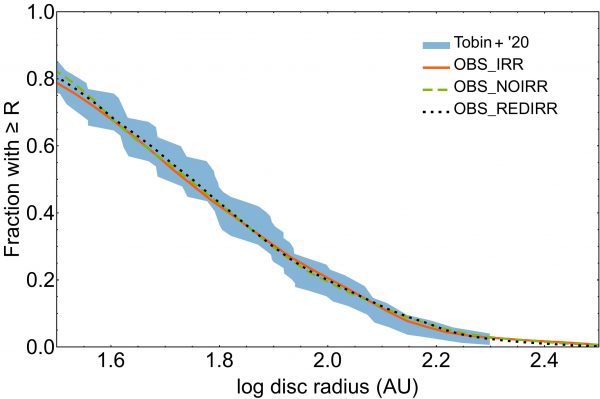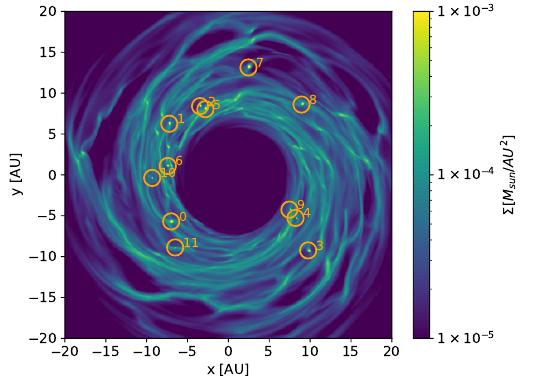Phase 3 – Working Group 11: Disc instability and its importance for the formation of planets
Context
Disc Instability (GI) was proposed as the primary pathway for planet formation long before the detection of the first exoplanet (Kuiper 1951). It has later been superseded by Core Accretion as the standard model for planet formation (Safronov 1972; Pollack et al. 1996), though disc instability remains the preferred mechanism for the formation of several classes of observed exoplanets.
Science
In recent years, an increasing body of evidence has been established for an early onset of planet formation (e.g. Manara et al. 2018). This calls into question a fundamental assumption common to many current studies on planet formation: Planets start to form in a smooth Class II disc. In the emerging new paradigm, where planet formation is much more strongly linked with the formation of stars, protoplanetary discs with masses comparable to that of their host star need to be studied. Such discs are governed by gravitational instabilities and the associated spiral arms that drive the transport of angular momentum. Some disc may even fragment under their own gravity and form bound clumps of gas.
Both the spiral arms and the gaps formed by GI-protoplanets may be responsible for some of the structures that have been observed in young discs in recent years (e.g. Isella et al. 2016; Zhang et al. 2018). Such structure can be studied observationally using facilities like ALMA and the VLA, and recently it has even become possible to detect planets that are still embedded in their birth environment (Currie et al. 2022; Benisty et al. 2021). We have already conducted a population synthesis study to assess how likely protoplanetary discs are to fragment. In a sample of discs that has radii and luminosities comparable to observations we found fragmentation in roughly 10 % of systems (Schib et al. 2023, Fig. 1). Fragmentation is also observed in MHD simulations of massive discs (Deng et al. 2021) and the associated fragments are in the super–Earth to Neptune mass–range (Fig. 2, Kubli et al. 2023). Whether clumps formed in this way can survive to become planets is the topic of ongoing research.

Figure 1: Cumulative distribution of the disc radii for different populations of discs studied in Schib et al. (2023), compared with observations. The run “OBS REDIRR” exhibits a distribution of luminosities comparable with observed Class 0 protostars and ∼10 % of its systems fragment.
Disc instability is important not only in protoplanetary discs but in astrophysical discs on different scales, like in AGN discs (e.g. Derdzinski & Mayer 2023). Some aspects, like the emergence and evolution of spiral arms, have been studied more extensively in the context of galaxies. One of the inherent difficulties in the study of disc instability is the large number of physical processes involved. Results from different disciplines of research need to be brought together in order to progress in the direction of a more complete picture.

Figure 2: Surface density of a fragmenting disc from an MHD simulation (Kubli et al. of 2023). Fragments are marked with circles.
Working group
The aim of this working group is to facilitate exchange and collaboration among PlanetS members from all institutions and beyond. The following will be key topics:
- Population synthesis of Disc Instability planets
- MHD simulations of fragmenting discs
- SPH simulations of clump interaction
- Migration and star formation in gravitationally unstable AGN discs
- Fragmentation of high-z galactic discs
- Observation of young protoplanetary discs and the structures therein
List of members/collaborators:
- Oliver Schib (UBE, C.3, coordinator)
- Christian Reinhardt (UZH, A.3, co-coordinator)
- Christoph Mordasini (UBE, C.3)
- Ravit Helled (UZH, B.1)
- Lucio Mayer (UZH, A.3)
- Joachim Stadel (UZH, A.3)
- Hans-Martin Schmid (ETHZ, A.1)
- Andrea Derdzinski (UZH)
- Noah Kubli (UZH, A.3)
- Thomas Meier (UZH, A.3)
- Simona Pacuraru (UHZ)
- Yoav Matzkevich (UZH)
Meetings
The first official meeting will be held on the 3rd July, 2023. Frequency and location of future meetings is yet to be established.
Contact
Please contact Oliver Schib (oliver [dot] schib [at] space.unibe.ch) with any questions concerning this working group.

